
Millions of people worldwide have benefited from laser-assisted in situ keratomileusis (LASIK) for correcting their vision. Correcting nearsightedness, farsightedness, and astigmatism using this method is safe and effective. The types of refractive errors that LASIK can correct will be discussed in conjunction with the origins of LASIK, the technology used, the number of procedures performed worldwide, and the number of procedures performed in each country.
LASIK's Brief History
A laser excimer is used to reshape the cornea in LASIK. Despite having been developed in the 1970s, this technology became widely used. With the excimer laser, precise amounts of tissue can be removed without causing any damage to surrounding tissues. Therefore, LASIK surgery on the cornea could be performed more precisely. LASIK was invented by Dr. Lucio Buratto in 1989 in Milan, Italy. Dr. Buratto created a thin flap in the cornea with a microkeratome to gain access to the underlying tissue. His next step was to reshape the cornea using an excimer laser and thus correct the patient's nearsightedness. This groundbreaking procedure was the beginning of a revolution in refractive surgery. LASIK technology has come a long way since its inception, and innovations are constantly being developed to improve the safety and effectiveness of the procedure. Some of the latest advancements in LASIK technology include: ReLEx SMILE (Small Incision Lenticule Extraction), a newer type of refractive surgery that uses a femtosecond laser to create a small, disc-shaped piece of corneal tissue then removed through a small incision. Some patients may find SMILE a good alternative to Femto LASIK because it is less invasive and does not create a flap during the procedure.
- Wavefront-guided LASIK: This technique uses advanced computer mapping technology to create a detailed 3D eye map, allowing for more precise customization of the LASIK procedure. There will be fewer side effects and better vision outcomes as a result.
- Topography-guided LASIK: This technique uses corneal topography, which measures the shape and curvature of the cornea, to guide the LASIK procedure. The results may be better for patients with irregular corneas and higher refractive errors. As part of the LASIK procedure, the first corneal flap is created with femtosecond lasers instead of microkeratomes. By reducing complications and improving safety, femtosecond lasers provide greater precision and control.
Technology Used in LASIK
Advanced technology is used to correct vision problems with LASIK, a two-stage procedure. The cornea is first flapped, then lifted, exposing the underlying tissue. Depending on the surgeon's preferences, a microkeratome or a femtosecond laser is used to perform this procedure. In the next step, heat is applied to the cornea after it has been shaped using an excimer laser. By removing precisely measured amounts of tissue, the laser corrects the patient's refractive error. As a result of the laser pulses, the cornea is reshaped without generating heat or damaging the surrounding tissue. The steps are painless and completed in just a few minutes. After the cornea has been reshaped, a corneal flap is placed back onto the eye. After the flap has been placed back onto the eye, the eye heals. Due to the quick healing of the cornea's surface, most patients notice an improvement in their vision within a few hours after the procedure.
Number of Procedures by Country
LASIK is popular worldwide, with millions of people undergoing surgery yearly. According to the International Society of Refractive Surgery, the United States is the leading country worldwide for LASIK procedures, with over 700,000 surgeries annually. Other countries with high LASIK surgeries include China, India, and South Korea.
Vision Problems Corrected by LASIK
The LASIK procedure can correct a variety of vision problems, including nearsightedness, farsightedness, and astigmatism. It is caused by a long eye or a steep cornea. Nearsightedness, or myopia, is characterized by a long eye or a steep cornea. In this situation, distant objects appear blurry because light focuses in front of the retina. LASIK can correct nearsightedness by removing tissue from the center of the cornea, making it flatter and allowing light to focus correctly on the retina.
As a result of a short eyeball or a flat cornea, hyperopia occurs. The result is that when we look at close objects, light is focused behind our retina. LASIK can correct farsightedness by removing tissue from the cornea's periphery, making it steeper and allowing light to focus correctly on the retina. The cornea's shape more closely resembles a football than a basketball, which causes light to focus on many different points on the retina. Consequently, all distances are blurry or distorted. When the cornea is reshaped to a more spherical shape by LASIK, light can focus on a single point on the retina, thus correcting astigmatism.
In addition to these common refractive errors, LASIK can also be used to correct presbyopia, an age-related condition that affects the ability to focus on close objects. During this procedure, one eye is corrected for distance vision and the other for close-up vision, a process called monovision. LASIK is not recommended for everyone, and the procedure's suitability depends on several factors, including the patient's age, prescription, and overall eye health. LASIK can only be determined with a thorough eye examination.
EDITORIAL POLICY
The Flash List is dedicated to providing trustworthy editorial content by maintaining strict ethical standards, journalistic integrity, and credible professionalism regardless of any remuneration as working media. The Flash List is not affiliated with third-party companies mentioned and makes no endorsement or guarantee expressed or implied. The preceding article, which contains affiliated link(s) for which compensation was received, is intended for informational reference only and does not constitute advice of any kind. Moreover, a qualified professional should be consulted regarding any lifestyle consideration, medical treatment, or monetary transaction, etc. Content is published in accordance with USFTC regulations and terms and conditions.
MORE ON THE FLASH LIST
































